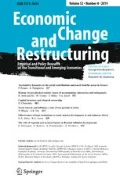Abstract
A model of development is presented where growth is initially driven by physical capital accumulation, as in the neoclassical model. After a critical level of physical capital is reached, the economy ‘takes off’ and enters a stage of sustained growth driven by human capital accumulation. The link between these two stages is provided by the assumption that private incentives for human capital accumulation increase with the average levels of human and physical capital. At the early stages of development, these incentives are low so the level of human capital stays stagnant until sufficient physical capital is accumulated. Other results are that some economies may reach a steady state of physical capital before a ‘take-off’ is possible. This is especially likely for economies in which agents have low savings propensities. Such economies remain stuck in a no-growth equilibrium forever. Economies that do grow may experience endogenous cycles if the return to investment in human capital is sufficiently increasing in the level of physical capital.
Similar content being viewed by others
References
Arrow, K. (1961), ‘The economic implications of learning by doing’,Review of Economic Studies, 29, 155–173.
Azariadis, C. and Drazen, A. (1990), ‘Threshold externalities in economic development’,Quarterly Journal of Economics, 105, 501–526.
Barro, R. (1991), ‘Economic growth in a cross section of countries’,Quarterly Journal of Economics, 106, 407–443.
Becker, G., Murphy, K. and Tamura, R. (1990), ‘Human capital, fertility and economic growth,Journal of Political Economy, 98, S13-S37.
Caballe, J. and Santos, M. (1993), ‘On endogenous growth with physical and human capital’,Journal of Political Economy, 101, 1042–1067.
De Long, J.B. and Summers, L. (1991), ‘Equipment investment and economic growth’,Quarterly Journal of Economics, 106, 445–502.
Denison, E. (1962), ‘Education, economic growth and gaps in information‘,Journal of Political Economy, 70, S124-S128.
Ehrlich, I. and Lui, F. (1991), ‘International trade, longevity, and economic growth’,Journal of Political Economy, 99, 1029–1059.
Galor, O. and Zeira, J. (1993), ‘Income distribution and macroeconomics’,Review of Economic Studies, 60, 35–52.
Haavelmo, T. (1954),A Study in the Theory of Economic Evolution, North-Holland, Amsterdam.
King, R. and Rebelo, S. (1990), ‘Public policy and economic growth: Developing neoclassical implications’,Journal of Political Economy, 98, S126-S150.
Lucas, R. (1988), ‘On the mechanics of economic development’,Journal of Monetary Economics, 22, 3–42.
Lucas, R. (1993), ‘Making a miracle’,Econometrica, 61, 251–272.
Quah, D. (1993), ‘Empirical cross section dynamics in economic growth’,European Economic Review, 37, 426–434.
Quah, D. (1994), ‘Convergence empirics across economies with (some) capital mobility’,London School of Economics Mimeo.
Rebelo, S. (1992), ‘Growth in open economies’,Centre for Economic Policy Research Discussion Paper No. 667.
Romer, P. (1990), ‘Endogenous technical change’,Journal of Political Economy, 98, S71-S102.
Sala-i-Martin, X. (1990), ‘Lecture notes on economic growth (II): five prototype models of endogenous growth’,NBER Working Paper No. 3564.
Schultz, T. (1960), ‘Capital formation by education’,Journal of Political Economy, 68, 571–583.
Solow, R.M. (1956), ‘A contribution to the theory of economic growth’,Quarterly Journal of Economics, 70, 65–94.
Stokey, N. (1991a), ‘Human capital, product quality, and growth’,Quarterly Journal of Economics, 106 587–616.
Stokey, N. (1991b), ‘The volume and composition of trade between rich and poor countries’,Review of Economic Studies, 58, 63–80.
Summers, R. and Heston, A. (1991), ‘The Penn World Table (Mark 5): an expanded set of international comparisons, 1950–1988’,Quarterly Journal of Economics, 106, 327–367.
Uzawa, H. (1965), ‘Optimum technical change in an aggregative model of economic growth’,International Economic Review, 6, 18–31.
Young, A. (1991), ‘Learning by doing and the dynamic effects of international trade’,Quarterly Journal of Economics, 1006, 369–406.
West, E.G. (1985), ‘Literacy and the Industrial Revolution’, in Mokyr J. (ed.),The Economics of the Industrial Revolution, George Allen and Unwin, London, pp. 227–240.
World Bank (1993),The East Asian Miracle: Economic Growth and Public Policy, Oxford University Press, New York.
Author information
Authors and Affiliations
Rights and permissions
About this article
Cite this article
Graca, J., Jafarey, S. & Philippopoulos, A. Interaction of human and physical capital in a model of endogenous growth. Econ Plann 28, 93–118 (1995). https://doi.org/10.1007/BF01263633
Issue Date:
DOI: https://doi.org/10.1007/BF01263633



